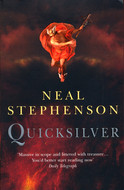Judging by the first book,
The Baroque Cycle is well named. Not mainly because that of the historical period it treats, but because it itself contains the key characteristics to such an extent. It does not come to expression so much in a particularly ornate language, but in a wealth of detail which is there, I think, not so much in order to create any sort of reality effect, but for its own sake. It could be he overdoes it a little at times, but if you are writing a
Baroque Cycle I suppose you might as well write a
Baroque cycle.
This can be exhausting. Certainly if, like me, you reach for books to check whether these historical ``facts'' are indeed facts or just facts of the fictional variety. This is the frustrating bit. Stephenson makes no secret of his novels having a fictional element, which means that it occasionally feels like reading a text book without the added bonus of being allowed to trust the information that textbook offers. The majority of the book, however, was so well researched, I was delighted. I had to force myself to stop checking up on it all after a while, and someone really could have told me that there was an appendix containing a list of
dramatis personæ in which the fictional were distinguished from the real (or as Stephenson puts it, some are historical, others might ``produce confusion, misunderstanding, severe injury, and death if relied upon by time travelers visiting the time and space in question''). He sometimes makes use of some rather stretched devices in order to include this research, and at other times he makes too much of information that is really common knowledge, but I won't quibble too much.
Stephenson gets stars aplenty for his research. I have always been vaguely insulted by authors who felt it was all right to riddle their novels with inaccuracies. It suggests, or states flat out, that they believe their readers will be too ignorant to notice the difference. Checking up on obscure facts and finding they were accurate made me very happy.
The real strength of the book is craftsmanship. Not just in terms of research, but also in the variety of literary styles. I am a little annoyed that this is not done in a coherent way, but the styles fit their subject so well, I have no real issue with it. He starts off playing with time, presenting the opening of the story as a series of protracted flashbacks from an old man trapped on a ship attacked by pirates, runs off into history and frolics about (there is no other word for it) with the Royal Society for a while, before changing the style completely into a semblance of the picaresque (which, of course, also has the picaresque novel as a participant). He also uses occasional bouts of drama to good effect, and large portions of the last third of the book take the epistolary form.
The book is divided into three sections. The first focuses on Daniel Waterhouse (fictional), a close friend of Isaac Newton (not so fictional) and a great and lovely cast of Royal Society members like Hooke, Wilkins, Boyle, Oldenburg and that lot in 1660s and 1670s London. The second is the picaresque, mainly focused on Jack Shaftoe, a Vagabond (also fictional). I wonder to what extent it is a coincidence that the portrayal of Daniel's youth is shown in apparently objective flashbacks, whereas Jack is allowed to tell his own story to a beautiful woman, with the truth value that entails. The third and final part is not so easily connected to
one character, but it is closely tied to Eliza, a former harem slave (and fictional to the extent that she comes from a fictional country) picked up by Jack in part two. Leibniz, rather than Newton, dominates the latter two halves, as the question of Leibniz and Newton and the Calculus hovers in the background throughout.
Historical figures like Huygens, Rossignol, Charles II, James II, William of Orange, Louis XIV and any number of others gravitate (oh dear) around these three protagonists with varying appeal, while the historical moment with its mix of experimental science, theoretical physics, alchemy and other murky activities is presented in full glory. I think he does a very good job of showing that the modern scientific theories did not spring pure and fully formed out of the head of Rationality, but are the result of a general willingness to try everything and investigate it all, while also showing off the fascination with the more spectacular elements (mercury and phosphorous in particular) -- after all, if they did not have spectacular properties, they would not look so cool, right?
I will not try to pronounce on the plot as a whole (I assume the missing resolutions of major questions will be dealt with in the following two volumes), and I would generally not dwell too much on Stephenson's language (while it does occasionally take on the flavour of the period, this sometimes succeeds and sometimes does not; but on the whole it is perfectly serviceable, although not something I would go into raptures about). I really wish there weren't quite so many gratuitous sex scenes. And if someone could properly explain to me how on earth the binary/I Ching code works in Eliza's letters, I will be both more impressed with Stephenson and very grateful to whoever does the explaining. But on the whole I recommend it to anyone with patience who is willing to get lost in the details of the period, particularly those with an interest in history and/or science.


Comments